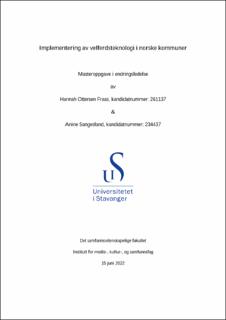| dc.contributor.advisor | Røvik, Kjell Arne | |
| dc.contributor.author | Sangesland, Anine | |
| dc.contributor.author | Fraas, Hannah Ottersen | |
| dc.date.accessioned | 2022-09-21T15:51:29Z | |
| dc.date.available | 2022-09-21T15:51:29Z | |
| dc.date.issued | 2022 | |
| dc.identifier | no.uis:inspera:109900289:65240225 | |
| dc.identifier.uri | https://hdl.handle.net/11250/3020284 | |
| dc.description.abstract | Denne studien ser nærmere på implementering av velferdsteknologi i norske kommuner. Hensikten er å bidra med økt kunnskap om implementering av velferdsteknologi i spesifikke kontekster. Vi har studert elektronisk medisineringsstøtte fra leverandøren Evondos i tre kommuner som alle har tatt medisinroboter i bruk i et omfang større enn landsgjennomsnittet. Studien fokuserer på hvilke faktorer i implementeringsprosesser som kan være vesentlige for at teknologier blir tatt i bruk.
Forskningsprosessen er gjennomført som stegvis-induktiv deduktiv metode, slik denne er beskrevet av Aksel Tjora (2017). For våre analyser benytter vi data som vi har samlet gjennom intervjuer med tre kommuner i løpet av perioden januar-mars 2022. Intervjuene er gjennomført med både administrativt ansatte og ansatte i førstelinjen i samtlige av kommunene. Som analytisk perspektiv er benyttet translasjonsteori.
Resultatene er oppsummert i følgende temaer: organisatorisk struktur, opplæring, adapsjon av teknologien, progresjon og utvikling, og involvering av tjenesteleverandør. Temaene analyseres i et translasjonsteoretisk perspektiv der det fremkommer viktigheten av translatørens rolle i implementeringsprosesser.
Hovedfunnene viser at Evondos som leverandør møter alle kommunene med et forslag til implementeringsløp de kan gjennomføre når de tar i bruk deres elektroniske medisineringsstøtte. Studien viser derfor at det ikke ser ut til at Evondos er hovedgrunnen til hvorfor disse kommunene ligger over landsgjennomsnittet i forhold til ibruktakning. Derimot, fremstår det å være translatørene i den enkelte kommunen som påvirker hvordan implementeringsprosessen utspiller seg. Samtlige av kommunene har foretatt valg i translasjonsprosessen som kan forklare hvorfor de har et høyt antall roboter i bruk i dag. Variasjonene mellom kommunene forstås med hensyn til hvordan kommunene har tatt ulikt eierskap til prosessen, har ulikt fokus på skillet mellom helse og teknologi, og hvor aktivt de har et helhetlig fokus på selve implementeringsprosessen. | |
| dc.description.abstract | This study takes a closer look at the implementation processes of welfare technology in Norwegian municipalities. The aim is to contribute to greater knowledge of the implementation processes involving welfare technologies in a given context. The study focuses on robots that are automatically dispensing medicine. For the purpose of this study, we have chosen to only include the robot from one distributor, namely Evondos. All the municipalities that are involved in the study have a greater number of Evondos-robots in use compared to the average in Norway. The study aims to identify what factors in the implementation process that could be essential to why the technology have been introduced and implemented.
The research process is based on Aksel Tjora’s SDI-model (2017). For the purpose of our analysis, we have included data gathered through interviews with the three municipalities during the period from January to March in 2022. Interviews were conducted with both the administration and the healthcare workers working directly with patient care in all the municipalities. The analytical perspective that are being used is translation theory.
The results have been summarized in the following subjects: organizational structure, training, adaption of the technology, progression and development, and the involvement with the distributor. The subjects have been analyzed in a translational theoretical perspective that have outlined the importance of the translator’s role in the implementation processes.
The key findings indicates that Evondos as a distributor gives the same service and offers identical programs for implementations processes to all the municipalities that are requesting their Evondos-robot. The findings therefore suggests that the service itself, or variations in how the service is offered to the municipalities, does not explain why some municipalities have more robots in use than others. The results suggests that it is the translators in the given municipality that affects how the implementation process progresses. All the municipalities in the study have taken active actions in the translation process that can explain why they have a high number of robots in use today. However, the variations between the municipalities can be understood as a result of how the municipalities have taken a different degree of ownership to the process, have a different focus on the separation between healthcare and technology, and how active they have had a holistic focus on the actual implementation process. | |
| dc.language | nob | |
| dc.publisher | uis | |
| dc.title | Implementering av velferdsteknologi i norske kommuner | |
| dc.type | Master thesis | |
